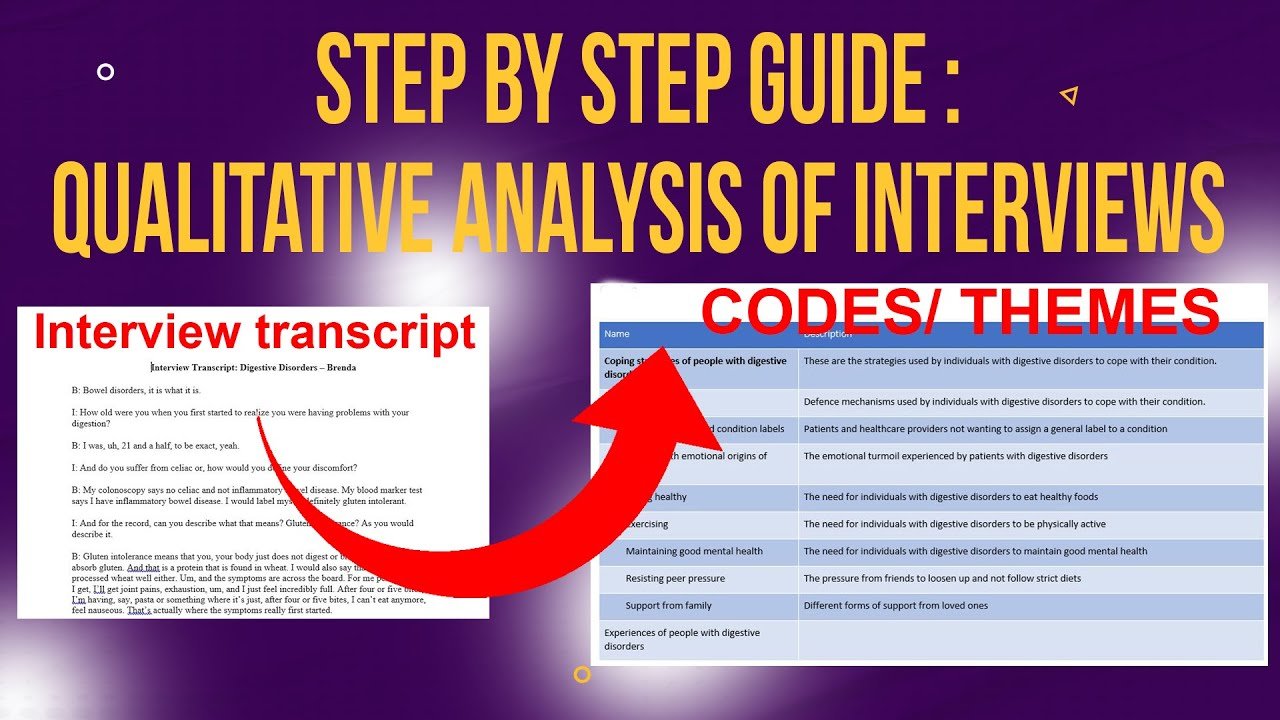How to analyze interview transcripts in qualitative research (RTA with Nvivo)
You have taken your time to design your questionnaire, conduct interviews, and perform the TBS transcription process.
Right now, you might be wondering, how will I analyze my interviews?
The Braun and Clarke Thematic Analysis Framework
After conducting a lot of research on this topic, I have found the most effective way to analyze interview transcripts is to follow a step-by-step approach popularized by Braun and Clarke in their scholarly article titled, Using thematic analysis in psychology.
This is the link for the article A Step-by-Step Process of Thematic Analysis to Develop a Conceptual Model in Qualitative Research
The main goal of Braun and Clarke’s article was to provide a step-by-step guide to help researchers conduct thematic analysis.
The Braun and Clarke approach to thematic analysis is known as reflexive thematic analysis.
The approach has continued to gain more prominence in scholarly research and has become even more refined.
In this article, we are going to conduct a reflexive thematic analysis together.
We’re going to use Nvivo 14. We are going to go from having interview transcripts to a well-organized data analysis report. This will all be possible after conducting the thematic analysis process.
After completing the thematic analysis process, there are six main steps in conducting thematic analysis, including:
- Familiarization with the data.
- Generating initial codes.
- Generating themes.
- Reviewing potential themes.
- Defining and naming themes.
- Producing the report
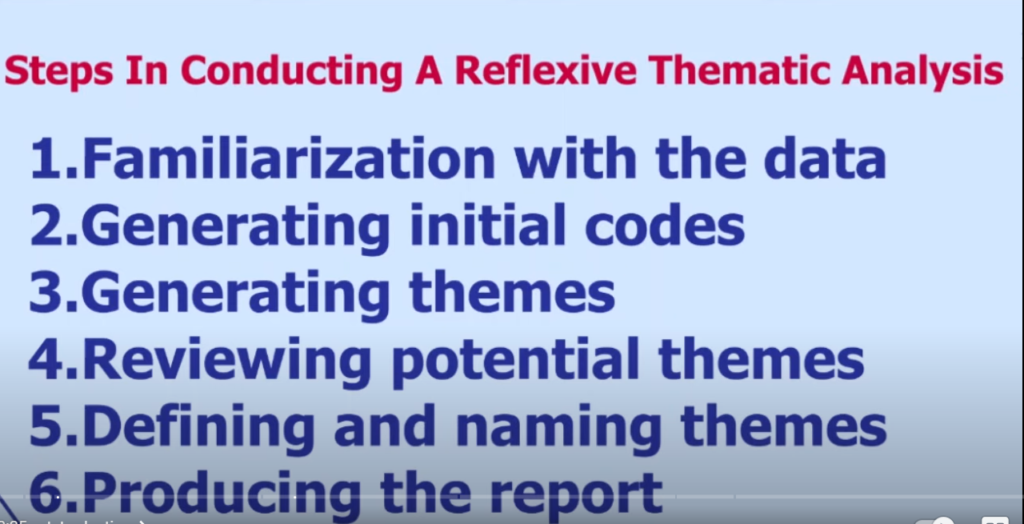
The Braun and Clarke Six Step Framework
For this article, we are going to use an example topic of young people identity in the media, a study of conceptions of self identity among the youth in Southern England.

The Study Title
For my study, I have six interview transcripts that I’m going to analyze using the reflexive thematic analysis approach.
The first thing I’m going to do is to create a new project. This is the button to create a new project in Nvivo.
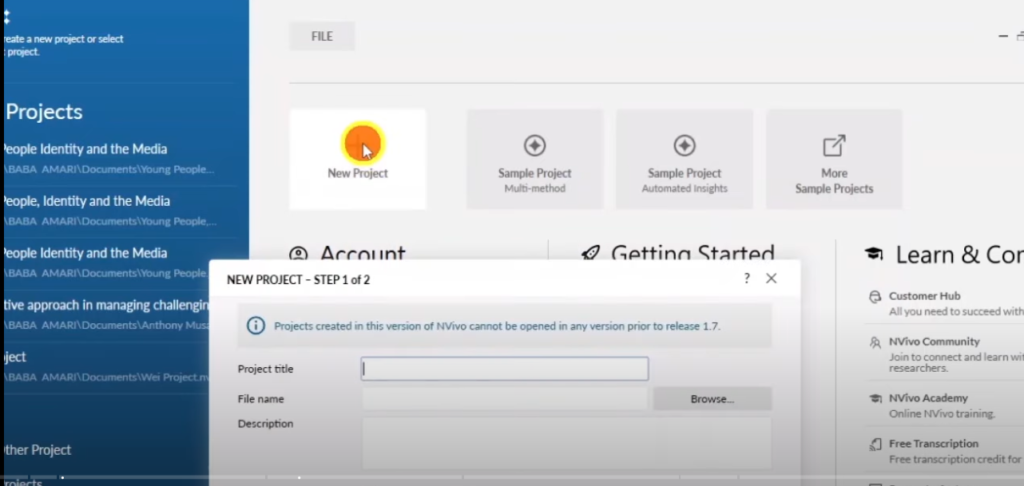
Creation of a New Project in Nvivo 14
I create a new project and call this Young People Identity and the Media Tutorial. Then I click Next. Then I click on Create Project. So Envivo has created my project.
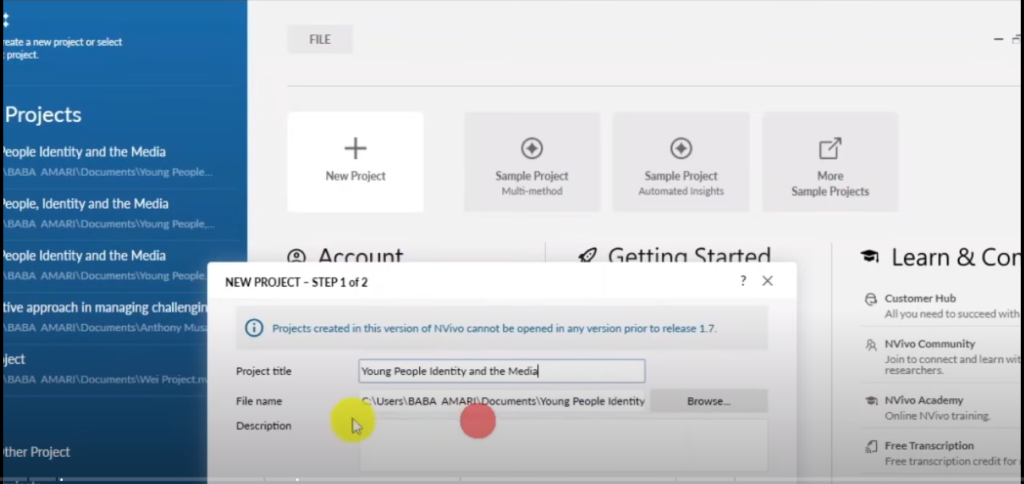
A New Project is Created in Nvivo 14
The first thing I’m going to do when I open Nvivo is to go to Files Section and create a new folder and call this interview transcript. Then I click OK.
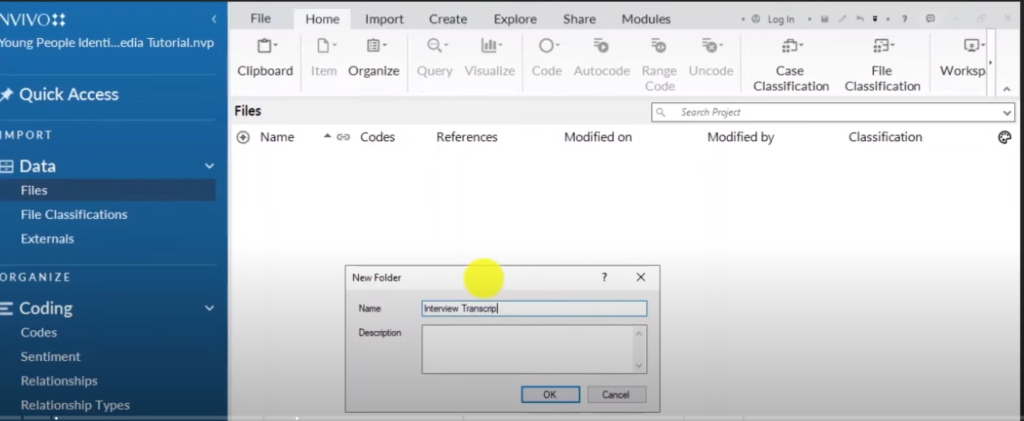
A New Folder is Created in Nvivo 14
We, have created a new folder called interview transcripts, where we are going to put all our interviews.
We are going to drag and drop our transcripts into the files section.
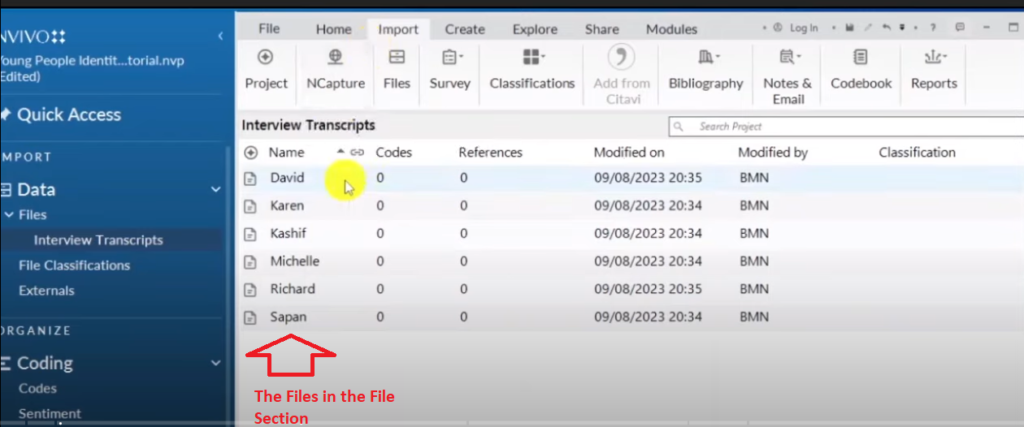
The Transcripts in the Files Section
Familiarizing with the Data
I can begin the first step of thematic analysis, which is familiarization with the data.
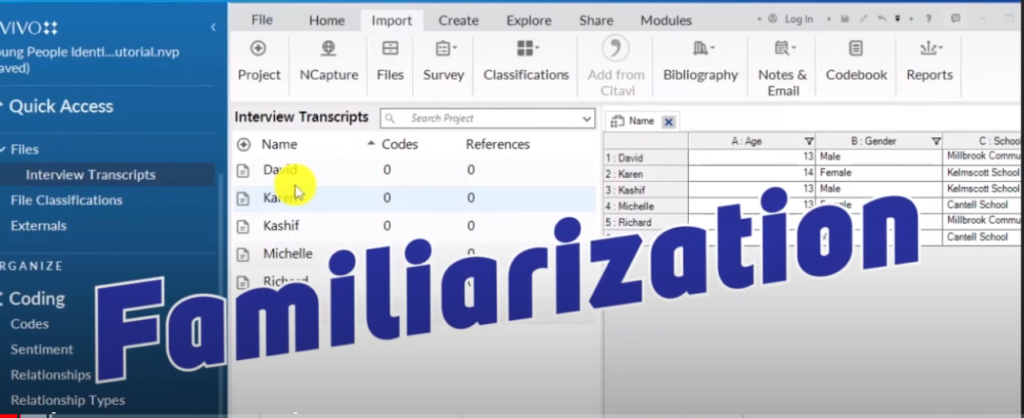
Familiarization with the Data
This step will basically involve going through each interview transcripts. I’m going to go through all of the interview transcripts.
Remember familiarization is not skimming.
You need to read like you would read a book and take time to understand your interview transcripts.
When conducting thematic analysis, the process of familiarization begins when you are transcribing your interview transcript.
As you transcribe your interview transcripts, you will familiarize yourself with such transcripts.
Generating Initial Codes
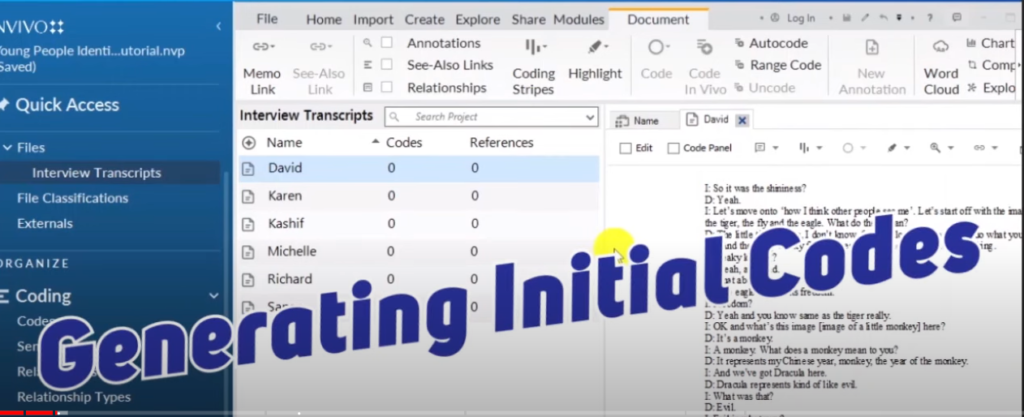
Generating Initial Codes
After familiarizing with all the interview transcripts, we are going to go to the second step of thematic analysis.
The second step of reflexive thematic analysis is generating initial codes. Let’s go through the interviews and generate some codes.
Because I have already familiarized with all my interview transcripts. You right click on the code section then you select new folder and call this initial codes.
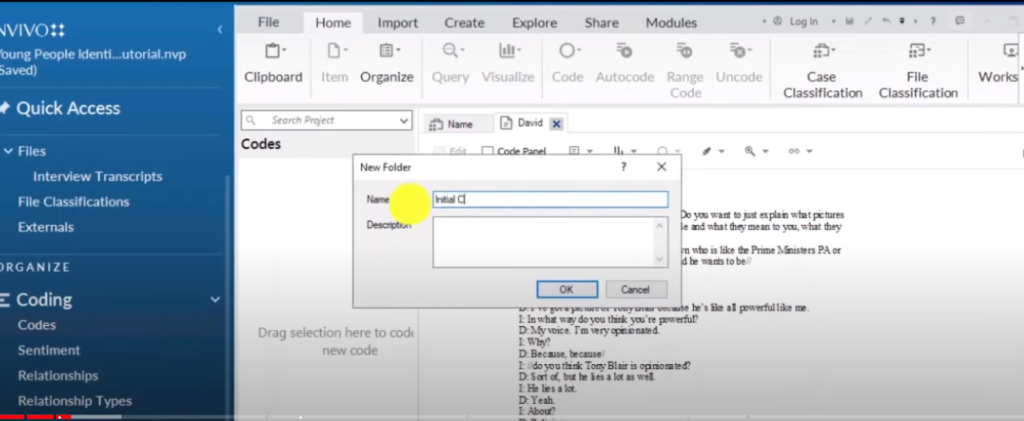
The Folder Initial Codes is Created
This interview transcript belongs to David, age 13, who is male.
I represents interviewer.
This study is about young people, identity, and the media. A study of conceptions of self identity among youth. In southern England, the interviewer says, okay, then David says, “I’ve got a picture of Tony Blair because he’s like all powerful like me.“
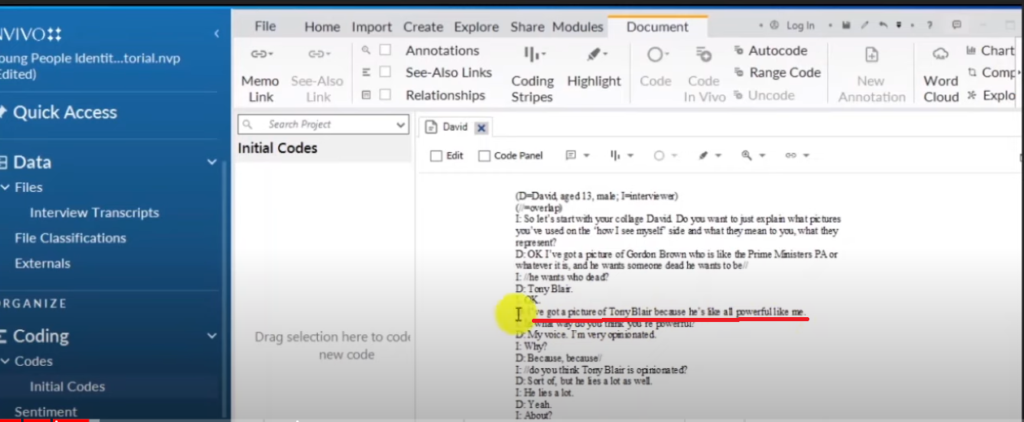
A Section of A Transcript in Nvivo 14
So we can code this area.
To code,we just highlight the sentence and we can drag it and drop it in the codes section.
We will call our code Powerful.
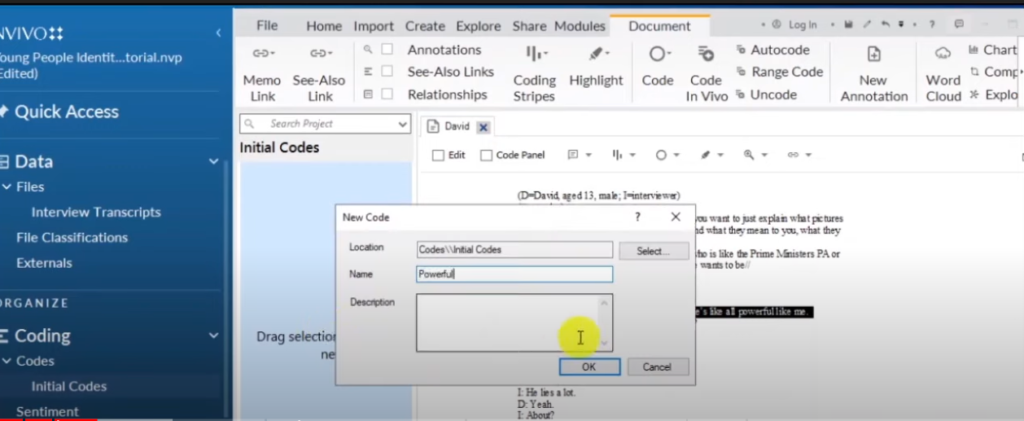
The Code Powerful is Created
I:”In what way do you think you are powerful? “My voice , I am very opinionated.”
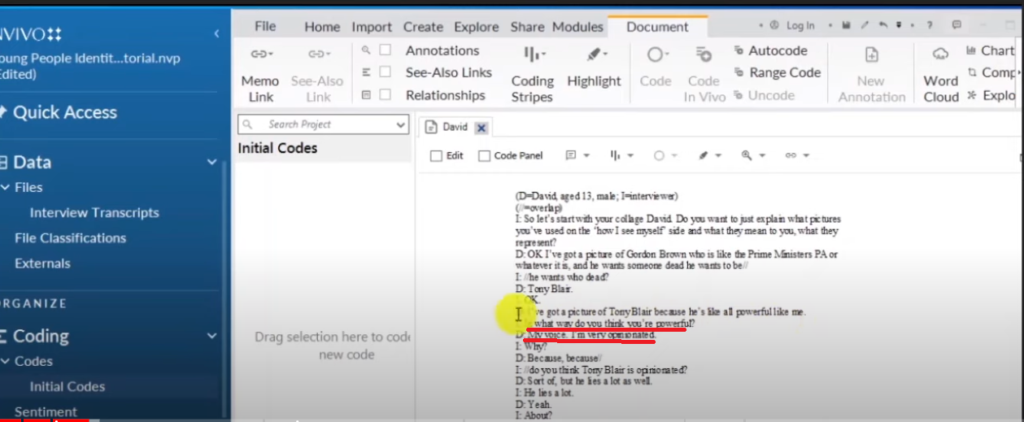
A Section of a Transcript in Nvivo 14
So we can also code this sentence as opinionated.
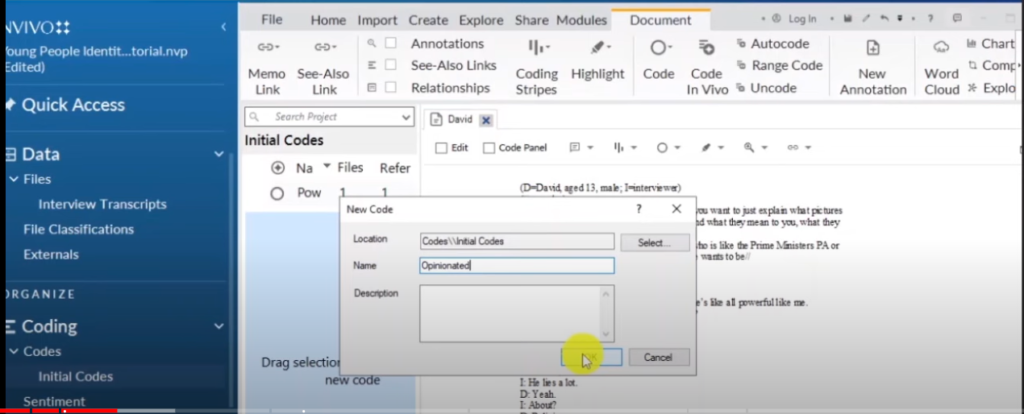
The Code Opinionated is Created
This is the self perception of this interviewee who is called David.
So, we can see that we have come up with two very clear codes for David.
I want to move to another interview.
If I was doing this in real time, which I’m going to do, I would go until the end of David’s transcript, but for now, let’s move to Karen.
So this is Karen, 14 female.
I: “Do you want to just go through your collage, how I see myself and explain what pictures you’ve used? And why you use them. The crossword is I think I’m intelligent.”
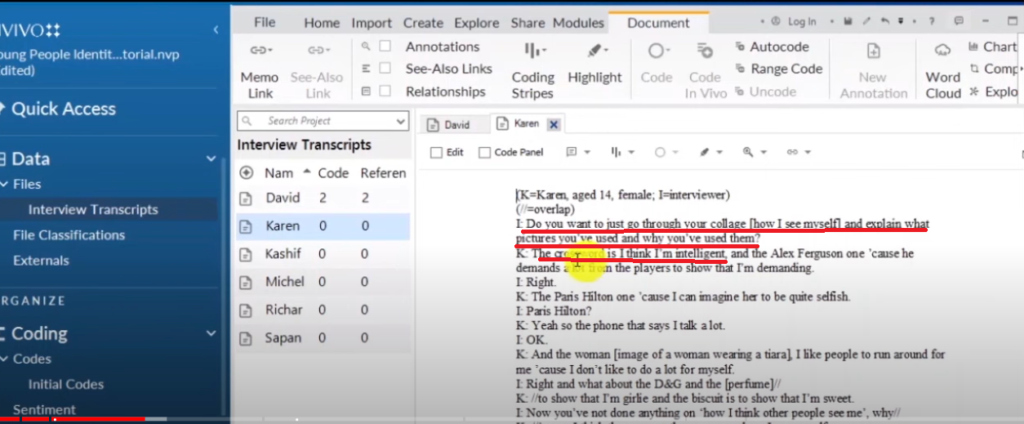
A Section of a Transcript in Nvivo 14
We code this as intelligent.
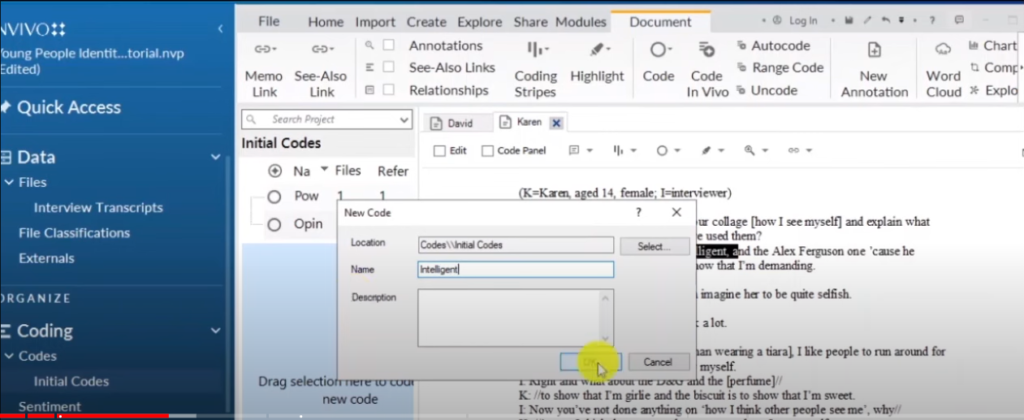
The Code Intelligent is Created
“And the Alex Ferguson one because he demands a lot from the players to show that I’m demanding.”
So she’s demanding. That’s a code.
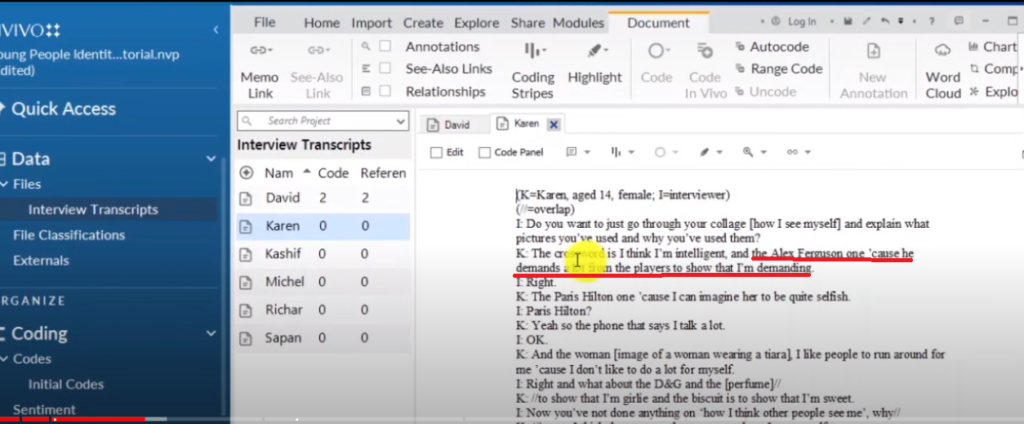
A Section of a Transcript in Nvivo 14
So she’s demanding. That’s a code.
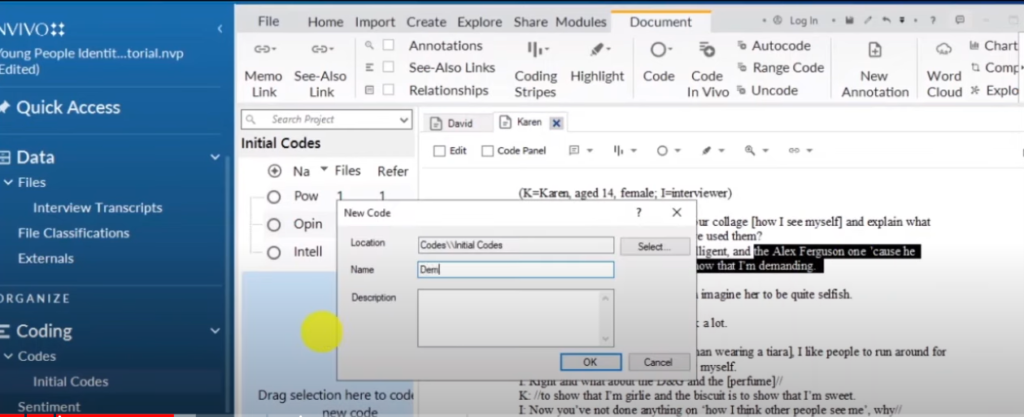
The Code Demanding is Created
So you can see we already have four codes here. We have powerful, opinionated, intelligent, and demanding.
Let’s put in more codes here for Karen.
So, “the Paris Hilton one, cause I can imagine her to be quite selfish.”
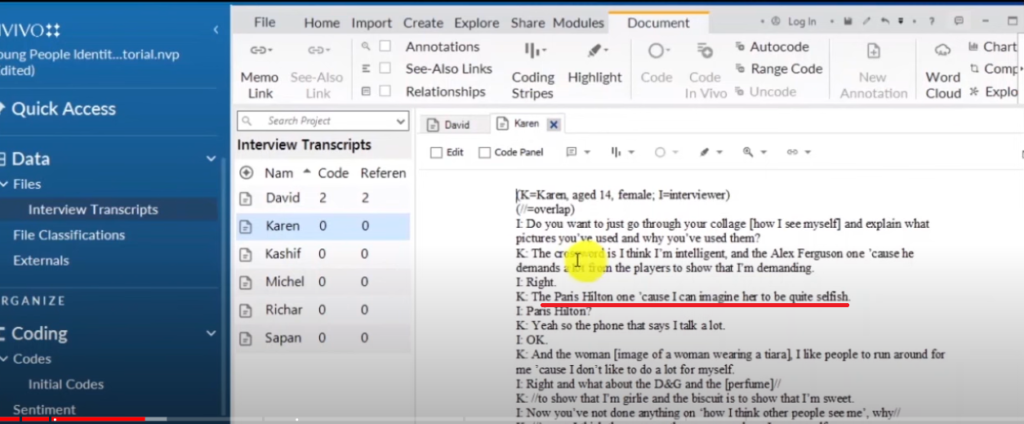
A Section of a Transcript in Nvivo 14
We can give her the code selfish.
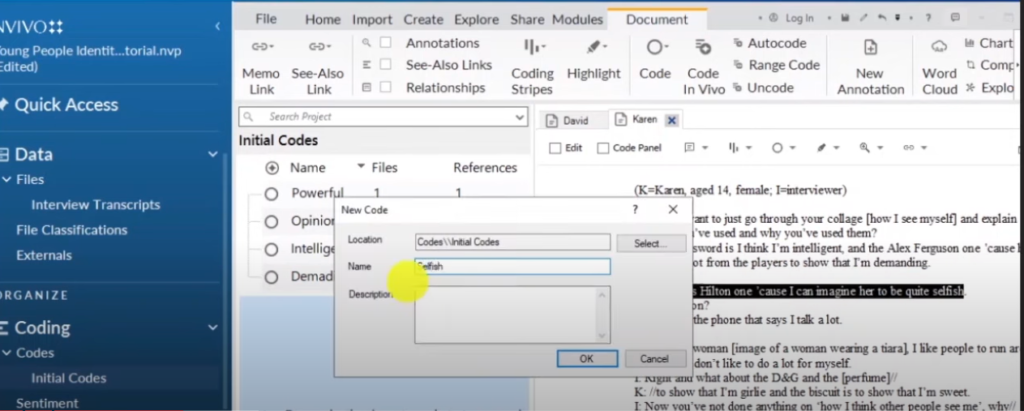
The Code Selfish is Created
“Yeah. So the phone that says I talk a lot.”
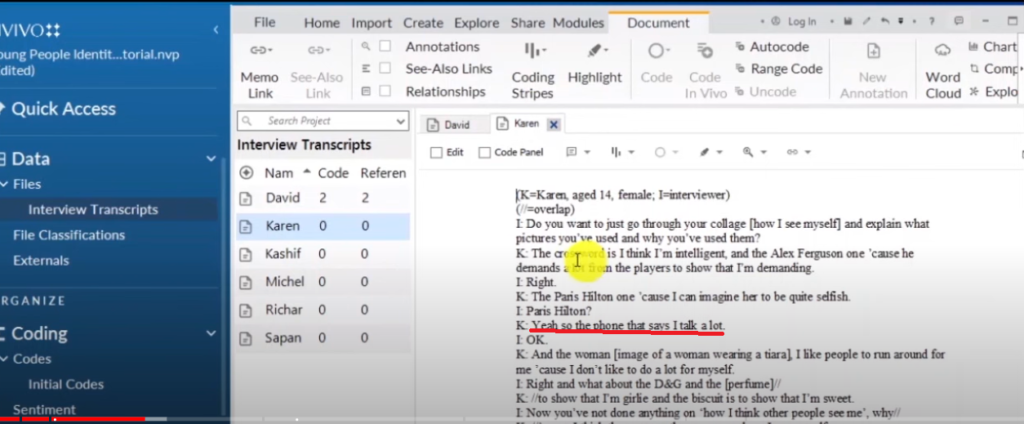
A Section of a Transcript in Nvivo 14
So this sentence of I talk a lot, we can code it as talkative.
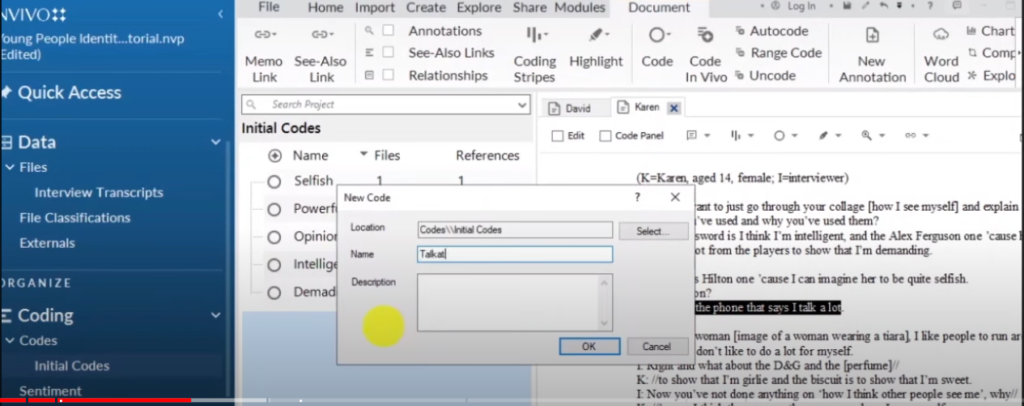
The Code Talkative is Created
So, this is how you code. Remember, there are two approaches to coding.
We have semantic, where we just take the open or the shallow meaning or the clear meaning. For example, yeah, so the phone says that I talk a lot. That I think is a bit semantic approach to coding.
Then we have latent approach to coding, where we look for the deeper meaning. Most of my codes here are semantic, but as we go on, we’ll see some examples of latent codes.
“And the woman, image of a woman wearing a tiara, I like people to run around for me because I don’t like to do a lot for myself.“
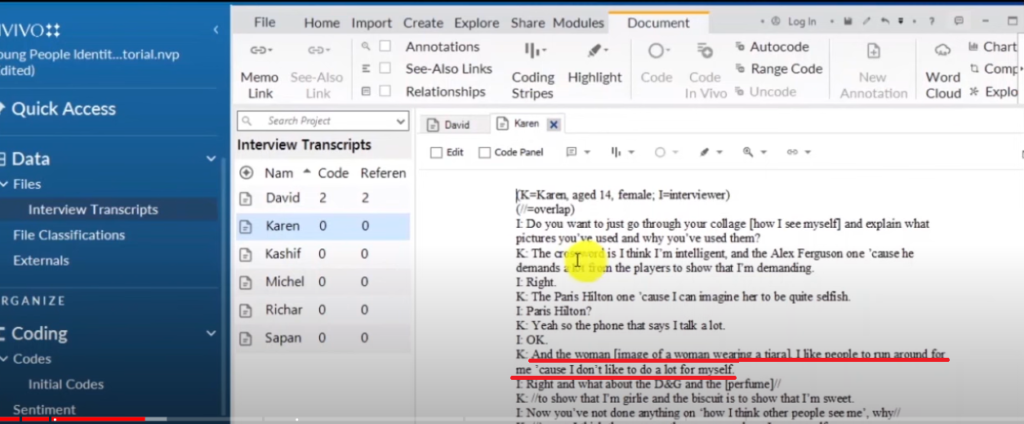
A Section of a Transcript in Nvivo 14
Here we can assign what I called a latent code. I don’t like to do a lot for myself. So we can call Karen lazy.
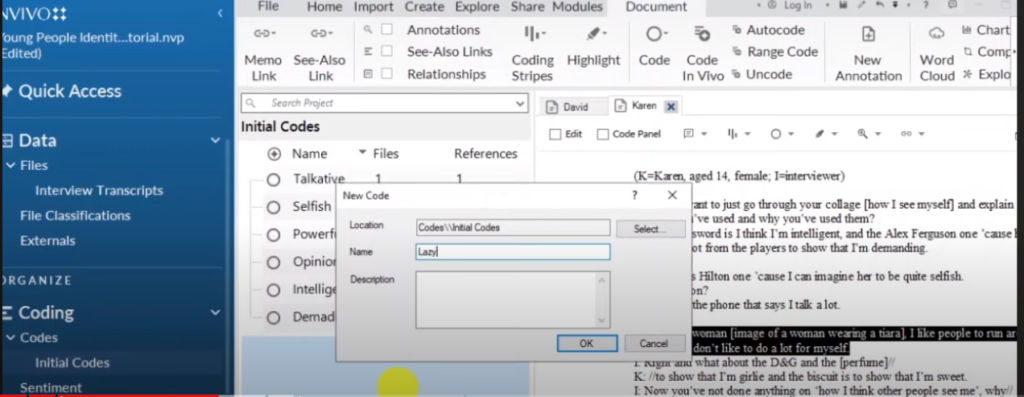
The Code Lazy is Created
That’s an example. Of a latent code, because there’s no way Karen says she’s lazy, but by reading the sentence, we can get the deeper meaning. “Like I don’t like to do a lot for myself in fuzz “or means that Karen is lazy.
Right. “What do you do about the D&G and the (perfume) to show that I’m girly and the biscuit to show that I’m sweet.“
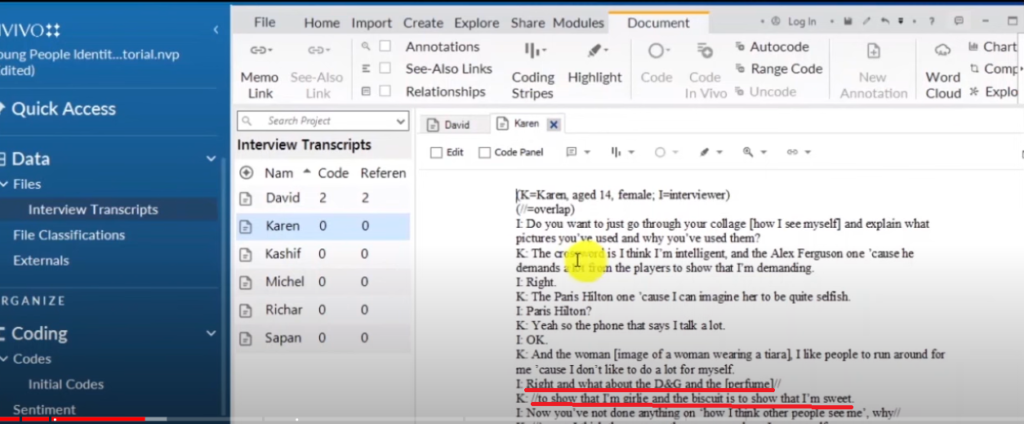
A Section of a Transcript in Nvivo 14
So, to show that I’m girly, we can code that again with a latent code or a latent code. We call this, Feminine.
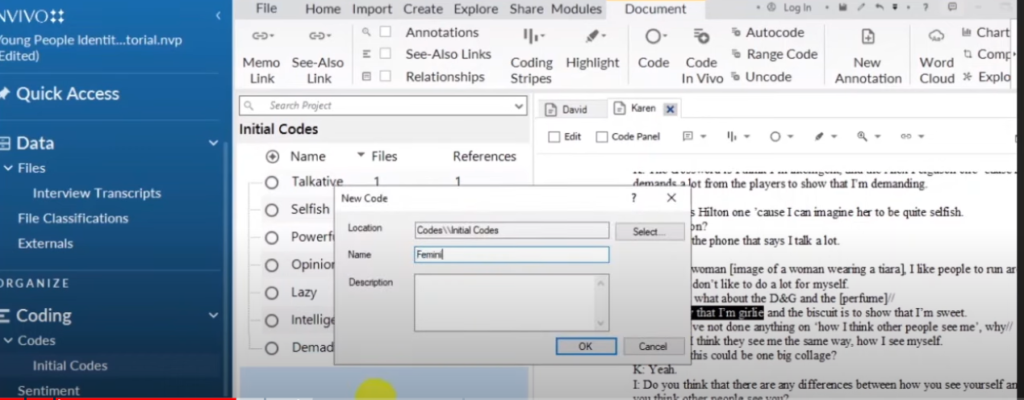
The Code Feminine is Created
“And then, and the biscuit is to show that I’m sweet.”
We can code that using the semantic code, which is sweet.
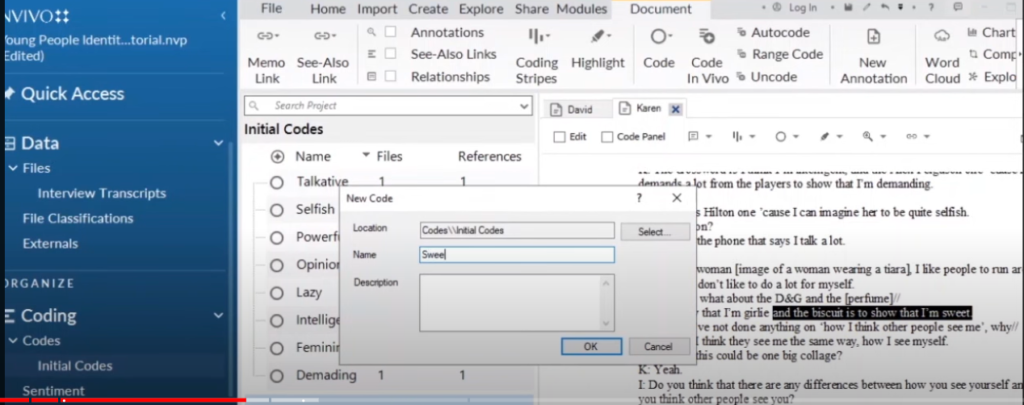
The Code Sweet is Created
That’s how you code your interview transcripts. And that’s how you come up with the initial codes.
So I’m going to go and take my time to generate all the initial codes and then we can move to the next step.
Now, I have taken my time to code all the interviews and you can see I have developed a very extensive list of initial codes. If you check here, I have 41 initial codes.
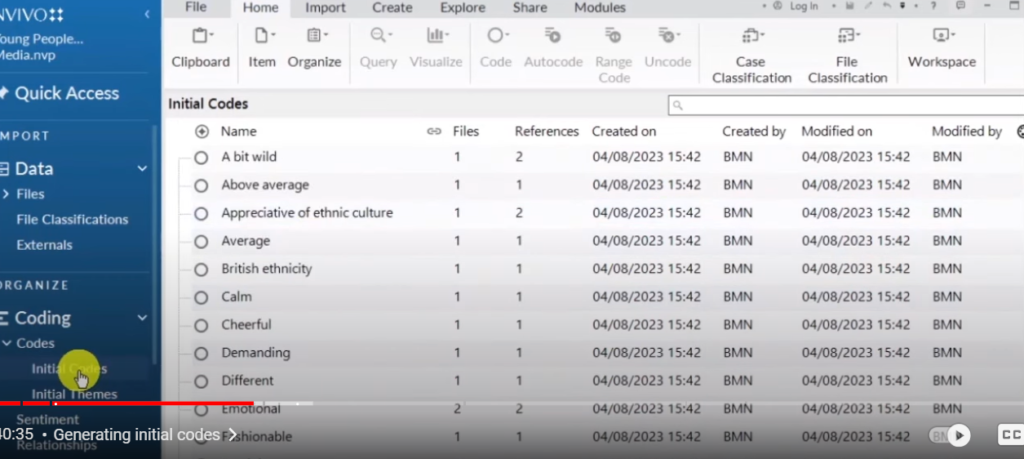
The Codes Generated after Analysis
That was the second step of reflexive thematic analysis, which is generating initial codes.
Generating Themes
Let’s move to the third step of reflexive thematic analysis, which is generating themes.
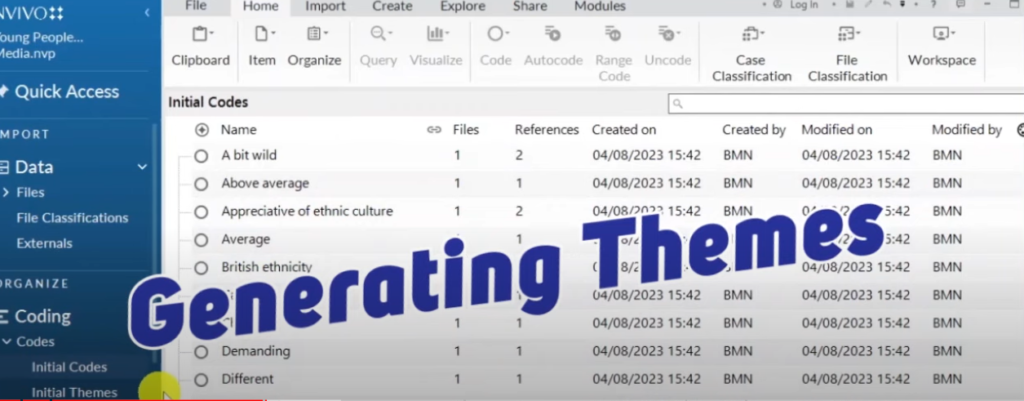
Generating Themes
Let’s come up with themes from our different codes.
I want to create a new folder in the codes. Section and call this initial themes.
So initial themes two.
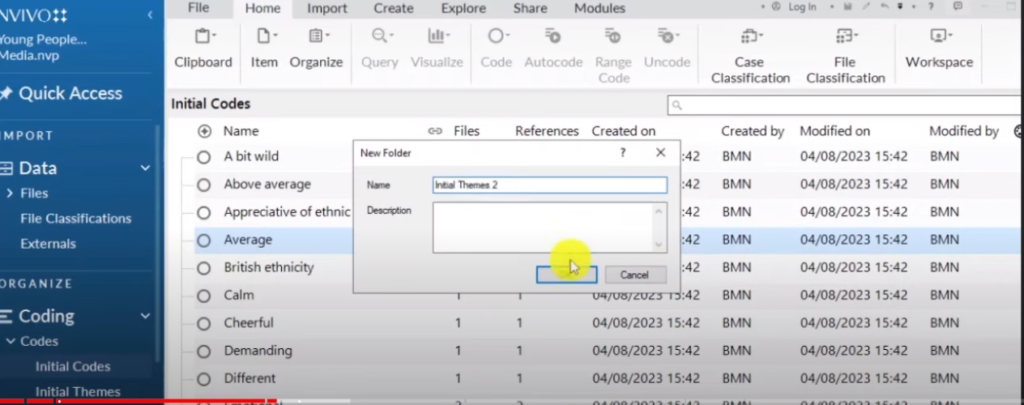
The Folder Initial Theme 2 is Created
If you look at our codes here, you will notice that we can generate some kind of themes.
If you look at the codes, a bit wild, above average, appreciative of ethnic culture, average, British ethnicity, calm, cheerful, demanding, different, emotional, fashionable, feminine.
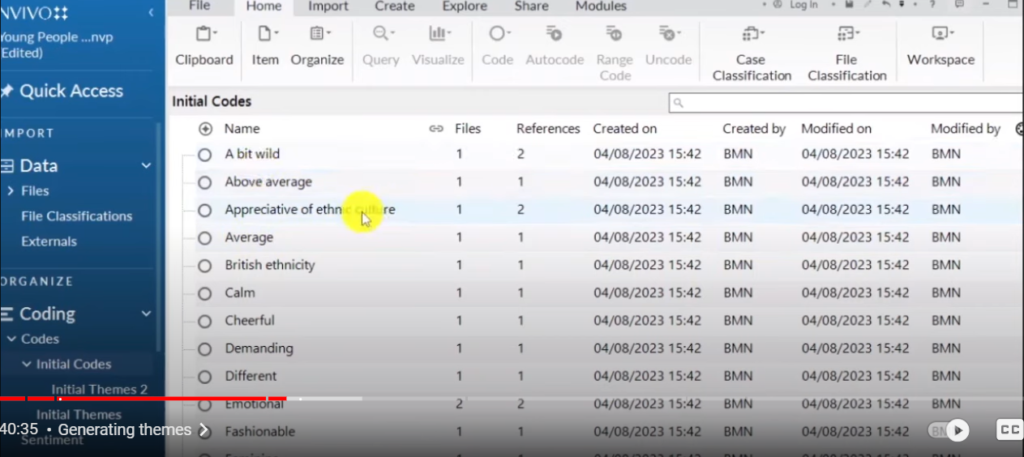
The Codes
You can observe something like these codes. tell us there is an element of positive attributes and negative attributes or positive traits and negative traits. For example, a bit world is a negative trait.
I create a new theme.
Let me call these positive traits, right?
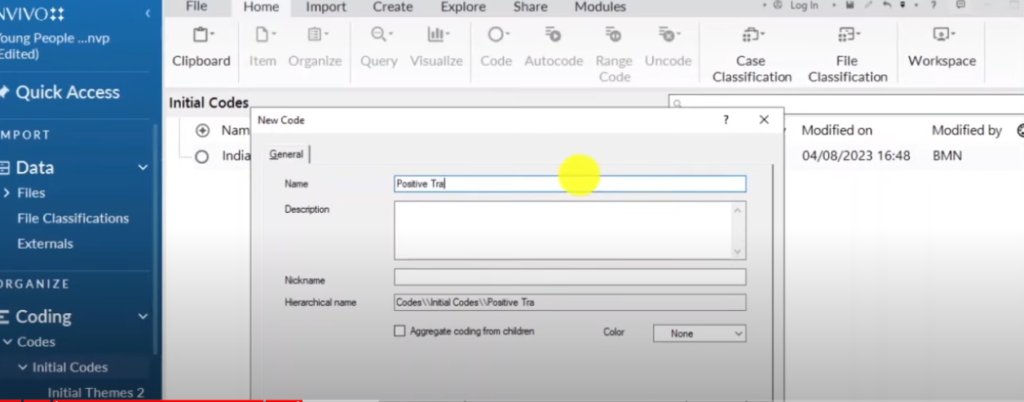
The Theme Positive Traits is Created
Then I want to create another theme and call these negative traits, right?
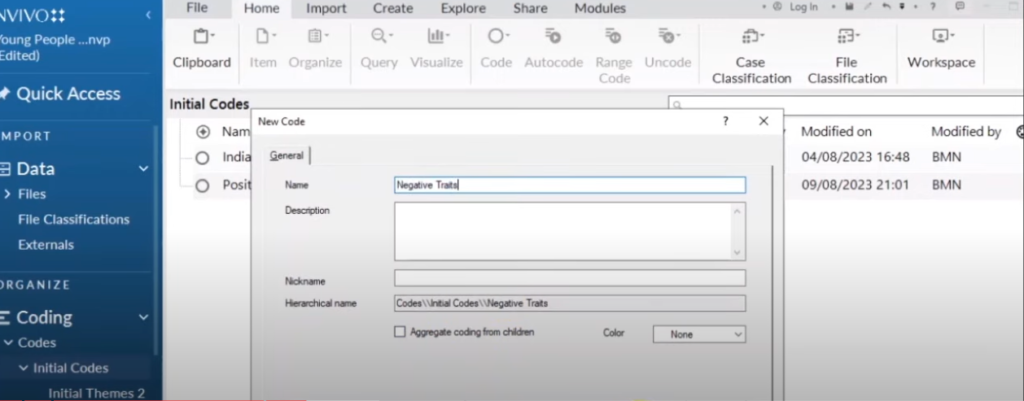
The Theme Negative Traits is Created
We are generating themes. Group of codes form a theme.
To generate themes, you first go through your codes, we read them through as we have done, and we have observed that we have positive and negative traits.
We will drag and drop all negative traits in the negative traits theme.
We will do the same for positive traits we drag and drop all of them into the theme positive traits.
There were also codes that came up about ethnicity so we will create a theme called ethnicity and drag and drop all codes that talked about ethnicity in the theme.
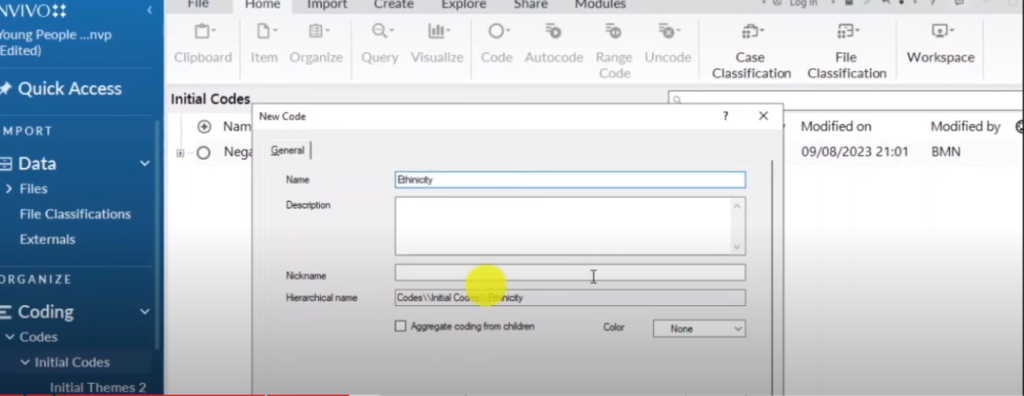
The Theme Ethnicity is Created
Remember, first we had initial codes, then we found some patterns in the codes to come up and to generate three main themes. That is positive traits, negative traits, and ethnicity.
Reviewing Potential Themes
After generating the initial themes, we are ready to move to the next step of the reflexive thematic analysis process, which is reviewing potential themes.
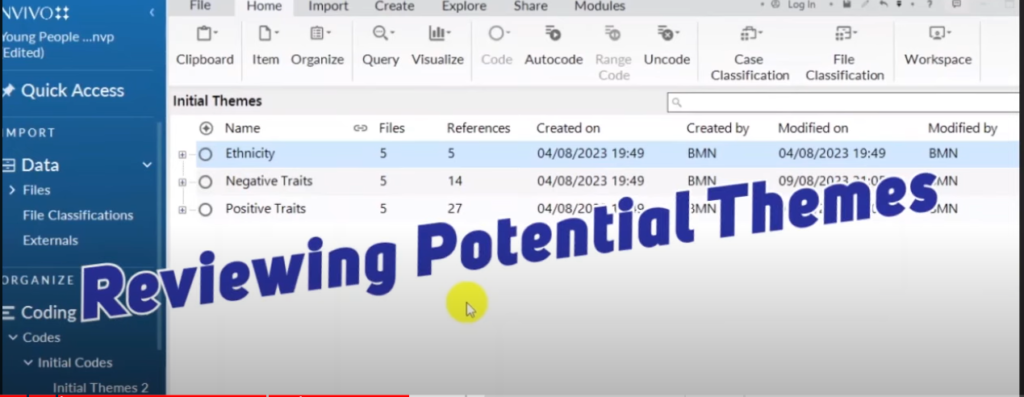
Reviewing Potential Theme
To review our potential themes, we have to actually go back, first we read our research topic and research question, so that we can review the themes and see whether they fit with our research question.
For this case, our research topic is young people, identity and the media, a study of conceptions of self identity among youth in Southern England.

The Research Topic
I had these research questions.
- What is the prevalent perception of the research participants about their ethnicity?
- Self perception among youth in Southern England?
- What is the opinion of youth in Southern England about how other people see them?
Now, if you look at my research questions, you will see my research questions talk much about perception.
The first research question, what is the perception of the research participants about their ethnicity? Talks about the theme of ethnicity.
The theme ethnicity already answers my first research question. So we can say this is a complete theme.
Let’s look at this second theme, negative traits.
If we look at our research question, what is the prevalent self perception among the youth in Southern England?
And then what is the opinion of youth in Southern England about how other people see them?
So, these negative traits do not directly answer our research questions.
The first thing we can do is to rename or review this theme and revise this theme. And let’s call these negative traits perceptions. And then we are going to have the next one.
Remember, we are reviewing and revising our themes, which is the fourth step of reflexive thematic analysis.
Now we have negative perception and positive perception.
We can see these themes still do not answer our research question. We want the themes to answer our research question of what is the prevalent self perception among youth in Southern England. What is the opinion of youth in southern England about how other people see them?
So, we need something about self perception which will be both positive and negative and other people’s perception which will be both positive and negative.
And I want to create a new theme called self perception.
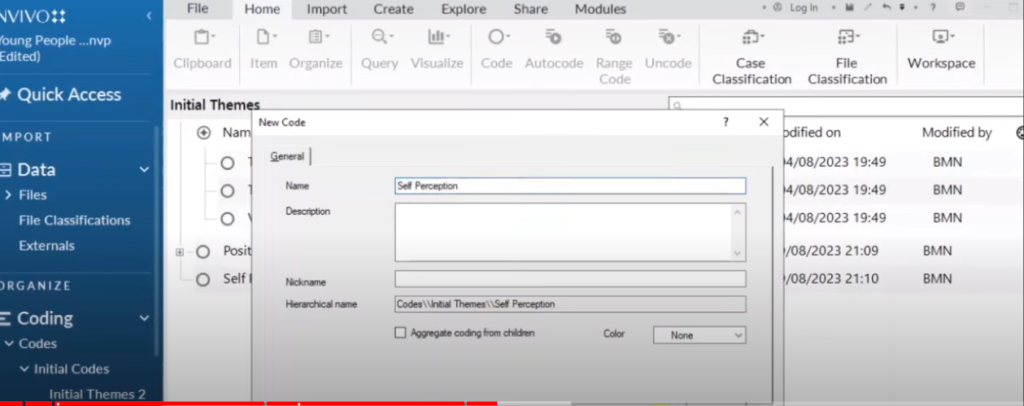
The Theme Self Perception is Created
We will also create another theme called other people’s perception.
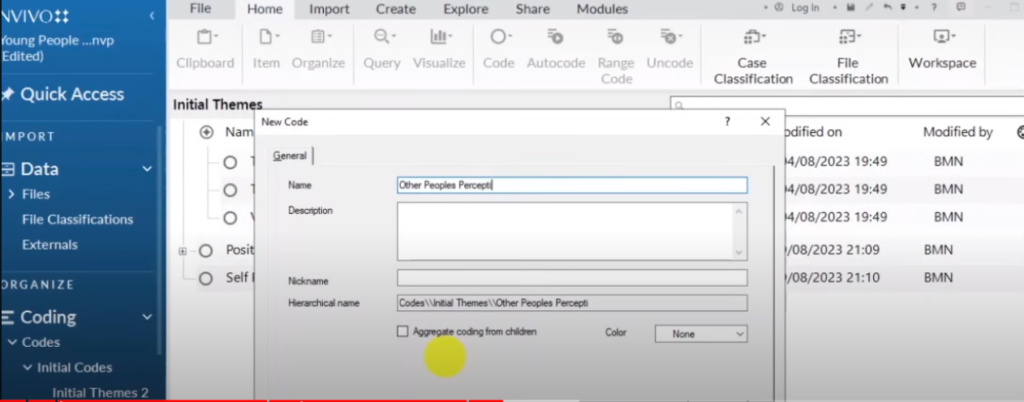
The Theme Other People’s Perception is Created
What does this mean that for the negative perception, it can be either self perception or other people’s perception and for the positive, it can be either self perception or other people’s perception.
Now I have created the self perception and the other people’s perception as themes.
The themes that answer our research question. Under the self perception, I want to create a new subtheme and call it negative.
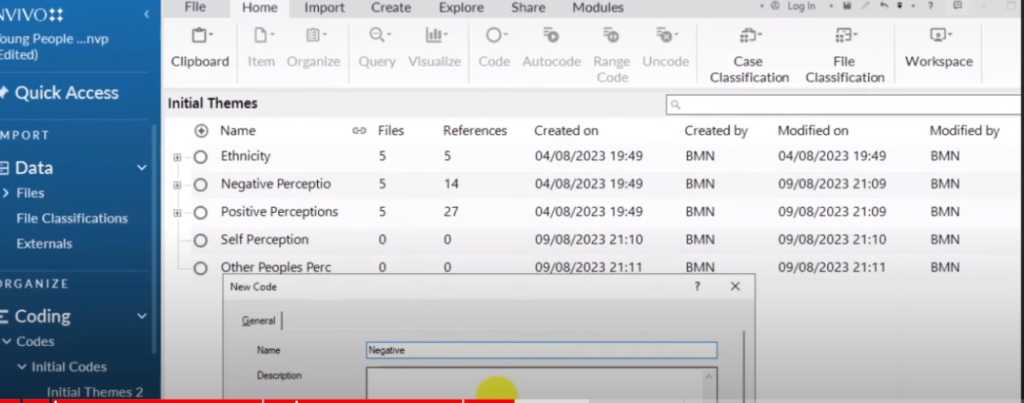
The Subtheme Negative is Created
And I want to create another and call it positive.
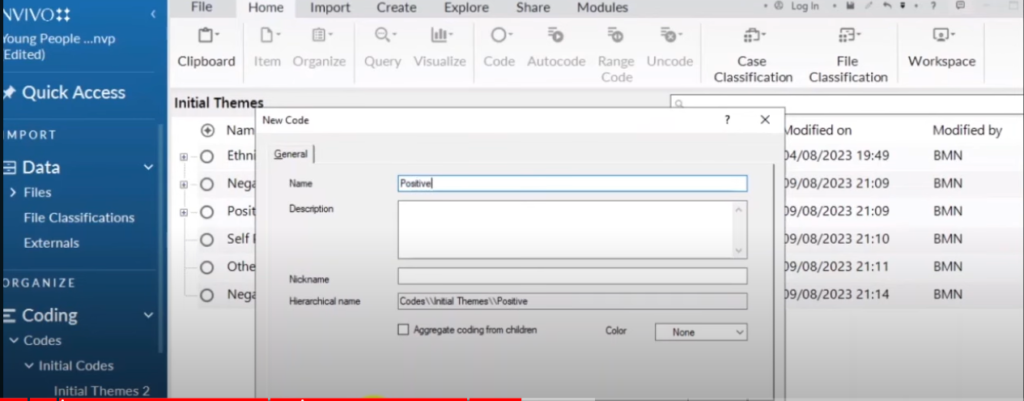
The Subtheme Positive is Created
I will also do the same for the other people’s perception. So other people’s perception can be positive and can also be negative.
After creating the themes and subthemes, I will go and assign codes to the theme self perception and other people’s perception.
This is how we review themes to make them to answer or to fit in our research question.
Remember, I’ve not changed my themes. I’ve just reviewed them and reorganized them in a way that it becomes easy for me to answer the research questions.
That’s how we perform the fourth step of reflexive thematic analysis, which is reviewing potential themes.
Defining and Naming Themes
Now I have the final themes here, and I am ready to move to the fifth step of reflexive thematic analysis, which is defining and naming.
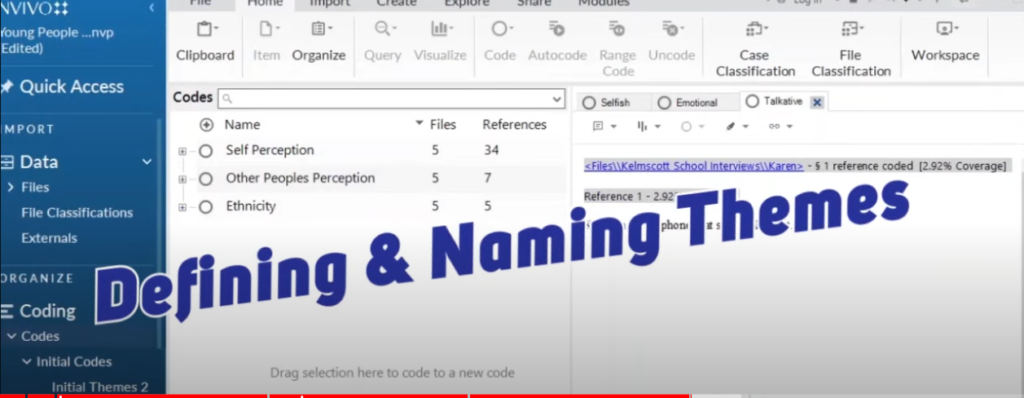
Defining and Naming Themes
In this step you go to the codes properties and describe what the themes are about.
You describe both the themes and the subthemes.
So that is the fifth step of reflexive thematic analysis. We are ready to move to the sixth and final step of reflexive thematic analysis, which is producing the report.
Producing the Report
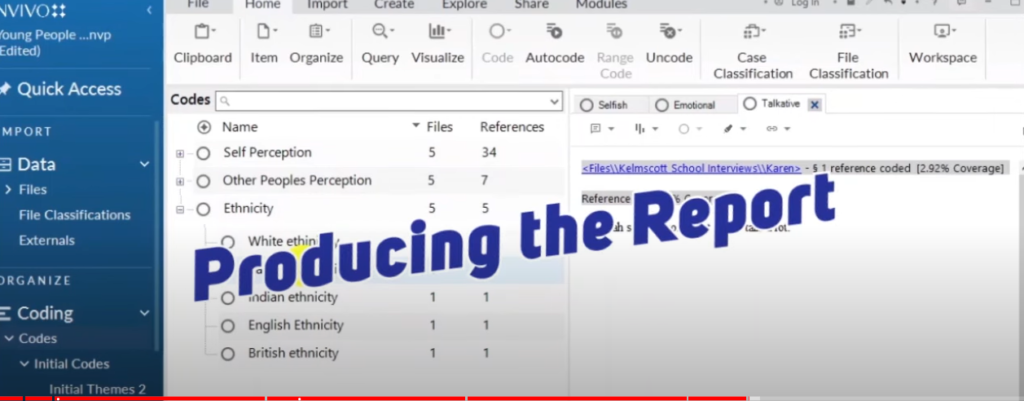
Producing the Report
To produce the reports, you might need to export different charts and visuals from Nvivo.
First you can export the initial codes. We have these initial codes.
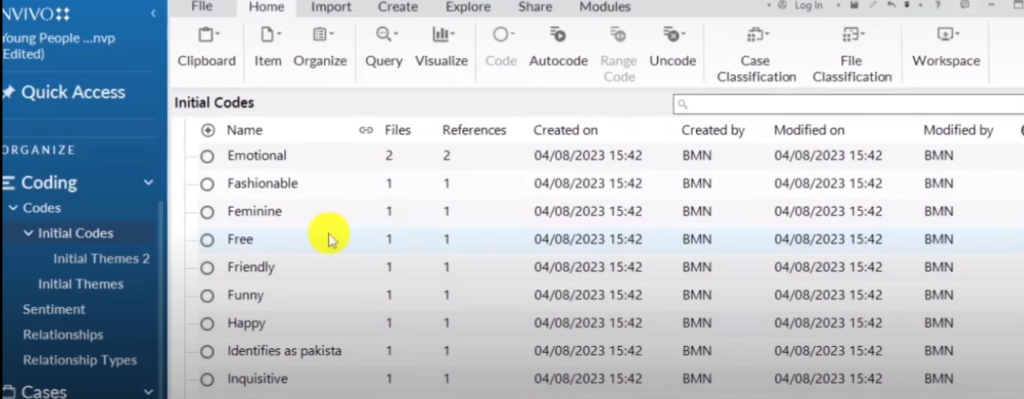
The Initial Codes
When we are writing the report from Nvivo, especially when we are using the Braun and Clarke thematic analysis approach, it’s important to have a table that shows our initial codes, our initial themes, and our final themes.
To export this, just go to where you have the folder for your initial codes we control all, ctrl A on your computer, right click and go to export and select export list.
This is what we just exported.
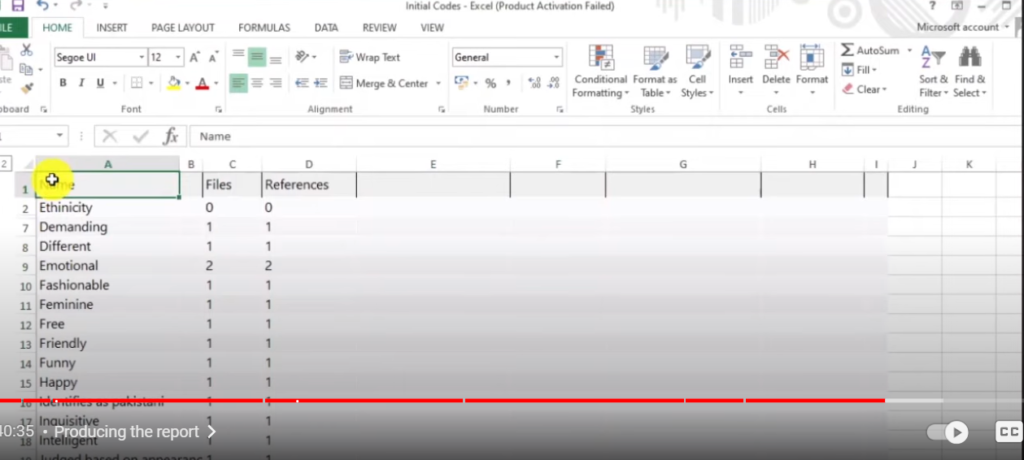
Initial Codes List
You can see these are our initial code. And you can come and highlight this and copy paste this table as the initial codes in your data analysis report.
That’s how you export tables from Nvivo. You just highlight and then right click export. Then you go to export list.
Another table we can export is our initial themes. Again, the same process, just ctrl A, export, export list, and save. And you can see if we open that, we get our initial theme here.
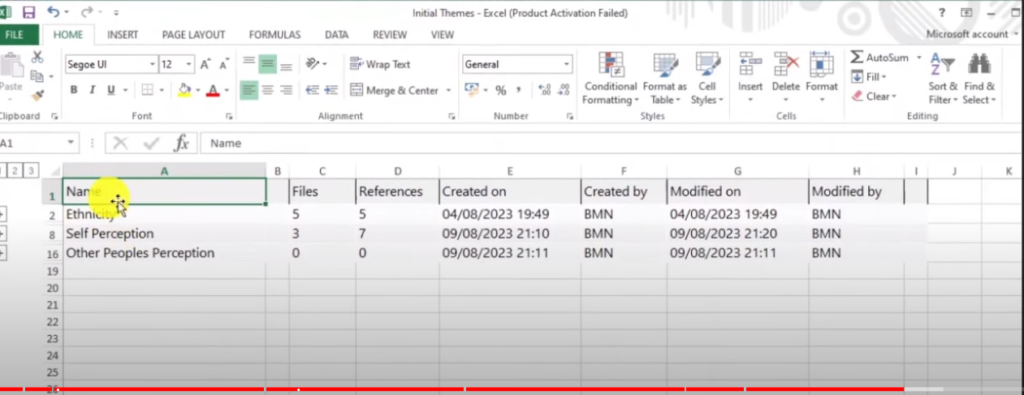
The Initial Themes List
These tables you can always copy and paste them in your final data analysis report.
Another visual that we can export from Nvivo is hierarchy charts.
If you right click on one of our themes and you go to visualize, then we can select hierarchy chart of codes, and then we’ll have all the codes under self perception.
We can go and click more inside and see. For example, this. This is the positive self perceptions of the interview participant.
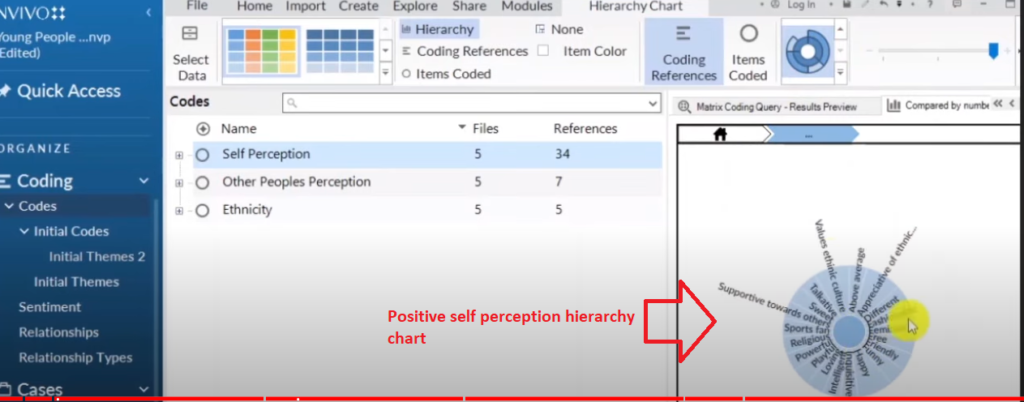
Positive Self Perception Hierarchy Chart
And we can also click on the negative and export this. This represents the negative self perception of the research participant.
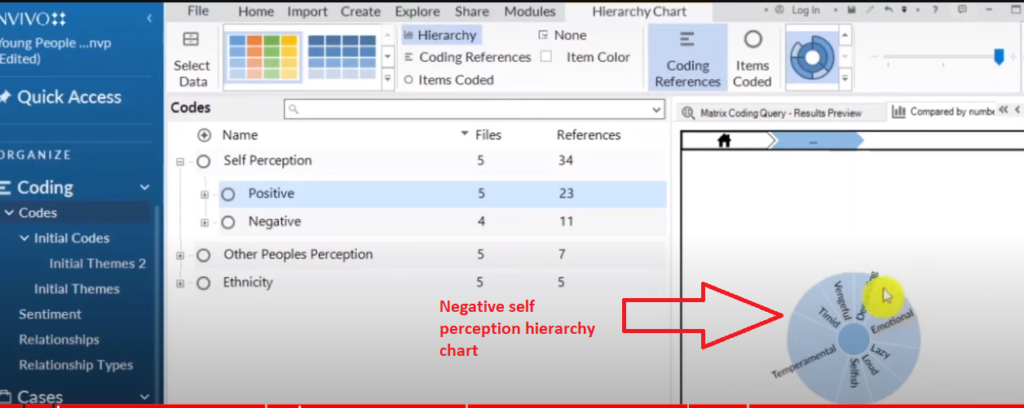
Negative Self Perception Hierarchy Chart
You can click control+ shift +E and to save that hierarchy chart.
So those are the different types of visualizations that we are going to include in our data analysis report after conducting thematic analysis.
Now, I have taken time to compile a final report after conducting the analysis.
In the report you first describe the data analysis process.
The data analysis section provides or highlights all the steps I took in conducting reflexive thematic analysis.
It’s important to include this in your report because it’s like providing evidence of how you conducted your analysis.
You also include visuals such as the tables that we earlier exported and a hierarchy chart.
You also discuss the themes that emerge and provide codes to further support the theme. The codes are then accompanied by the participants excerpts.
To access the entire report, click here Sample findings report
